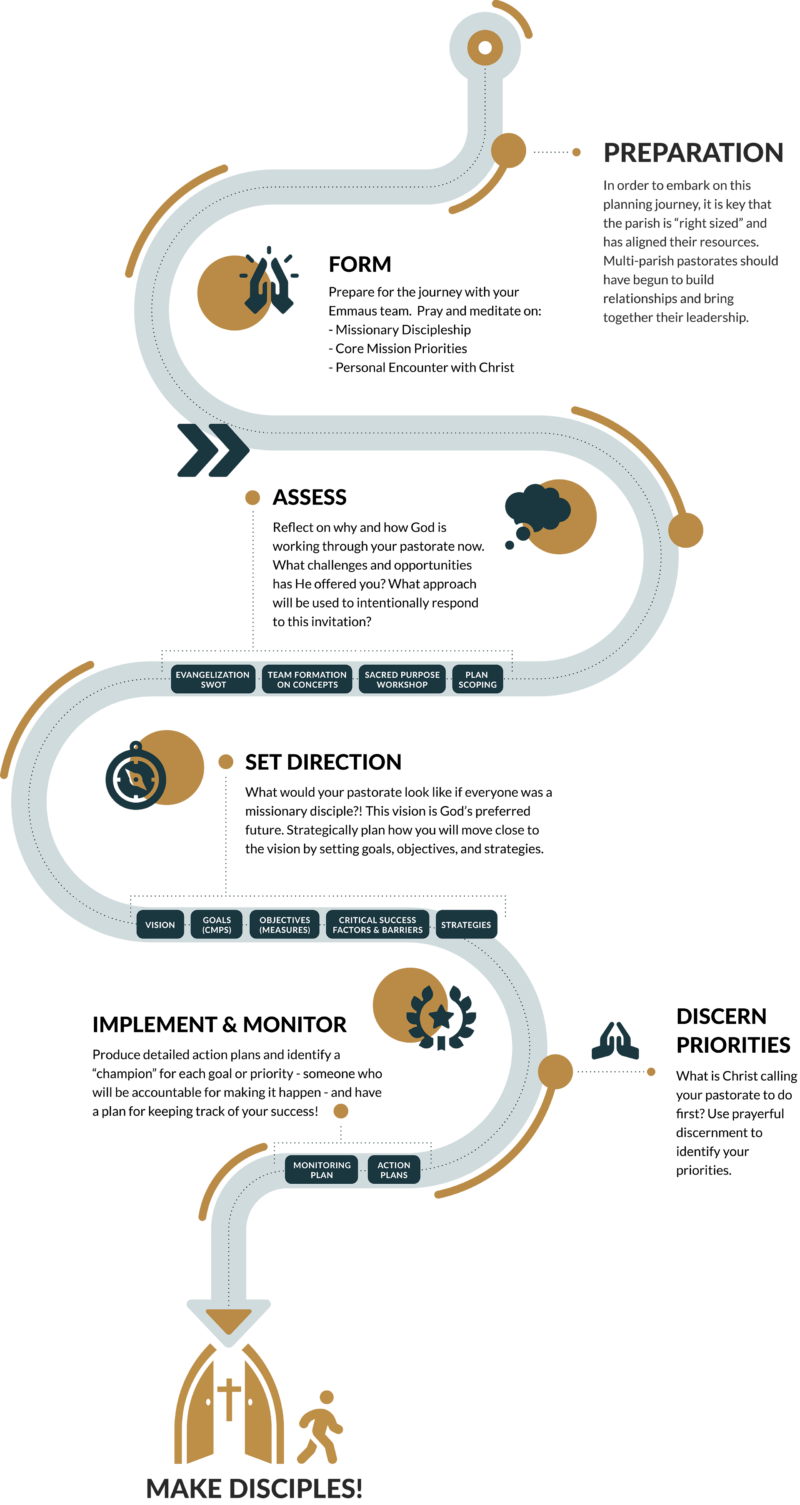PREPARATION – Activities in preparation for planning activation including educating key leaders on what missionary discipleship is and what other parishes have been doing, and building relationships between multi-parish pastorates.
SACRED PURPOSE WORKSHOP – A mini-retreat led by the Emmaus Team in which key people in the pastorate reflect on why and how God is working through the pastorate now. A statement is developed that describes what the pastorate does, for who and to what benefit.
PLAN SCOPING – The Emmaus Team, pastor, and other key leaders outline the unique planning process that will be followed. It should integrate existing plans, reflect pastorate-specific circumstances, and provide times for parishioner input.
TEAM FORMATION ON CONCEPTS – Once a Pastorate Planning Team (PPT) is formed, the Emmaus Team leads a review of and discussion on key planning terms and concepts, community demographics, and parish data and trends. This forms a strong foundation for moving into evangelization-based planning.
EVANGELIZATION SWOT – An active exercise the Emmaus Team leads the PPT through to consider the pastorate’s Strengths, Weaknesses, Opportunities, and Threats relative to evangelization.
VISION – The Emmaus Team leads the PPT through a series of exercises to imagine the pastorate in a few years when it is full of missionary disciples. This produces a Vision Statement that describes “God’s preferred future” for the pastorate.
GOALS (CMPS) – Typically, the goals for a pastorate’s plan are the six Core Mission Priorities (CMPs), those aspects of discipleship that make pastorates vibrant, sustainable centers of evangelization. The CMPs are liturgy, welcome, encounter, accompaniment, sending, and mission support.
OBJECTIVES (MEASURES) – The Emmaus Team facilitates the PPT in setting objectives that measure progress and help to quantify if the goals are being met. Objectives should be SMART – specific, measurable, attainable, relevant, and time bound.
CRITICAL SUCCESS FACTORS (CSFS) AND BARRIERS – The PPT identifies CSFs (things that must be in place to achieve the goals and/or objectives) – and barriers (those things that can prevent achievement of the goals and/or objectives). Subsequent strategies should overcome the barriers and create the conditions for the CSFs.
STRATEGIES – The Emmaus Team facilitates the PPT in identifying specific initiatives that can be taken to achieve a goal and/or particular objective in support of the overall vision. A number of strategies will be developed for each goal.
PRIORITIES – Once strategies are identified, they must be prioritized in light of capacity and available resources. Here the Emmaus Team helps the PPT discern priorities through prayer and discussion.
ACTION PLAN – For each priority, an action plan is developed that details the steps, timeframe, people, and resources needed to implement it. The action plan is produced and executed by a “champion” – someone identified by the PPT as being responsible for that priority.
MONITORING PLAN – Work on the action plans must be monitored for progress. The monitoring plan establishes a framework for regular communication throughout the year on the implementation of the priorities and any barriers or new directions that have been identified in the process.
MAKE DISCIPLES – As the strategies are implemented, God-willing, even more disciples are made at the pastorate!


